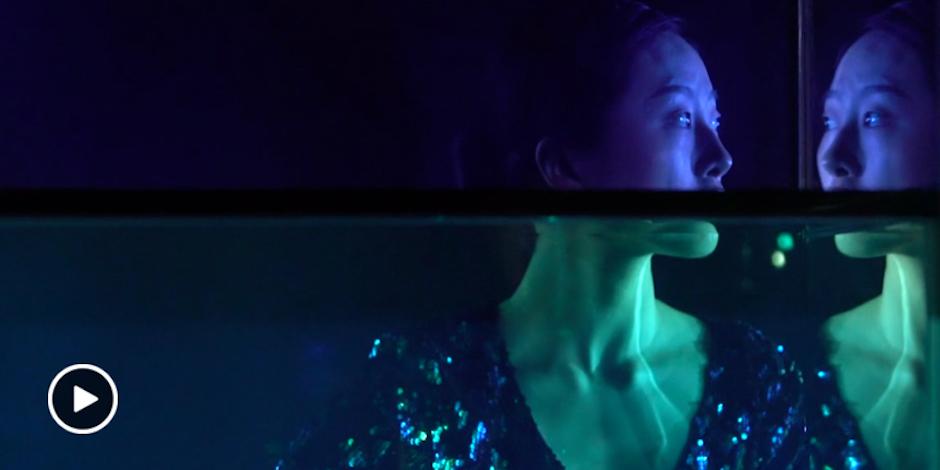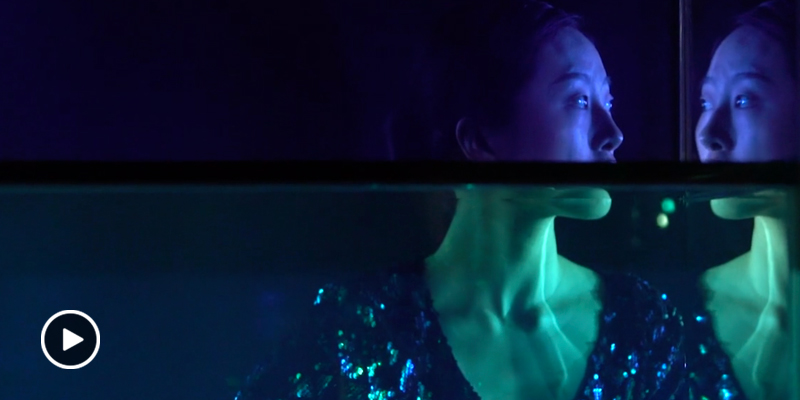A doorbell rings, the mail is delivered, and a woman’s world is shattered. What follows in Associate Arts Professor Aly Rose’s 14-minute dance film, “The Leaving Room,” is a stylistically kitsch exploration of a woman’s coming to terms with the end of a chapter in her life.
Starring NYU Shanghai Assistant Arts Professor Tao Siye as the wronged wife alongside several students and staff members, and filmed on campus as well as at the Glass Museum of Shanghai, “The Leaving Room,” has already won several film festival awards and selections including at the Global Indie Film Festival, Experimental Dance & Music Festival, Asians on Film, the San Jose International Film Awards, and Vegas Movie Awards.
“‘The Leaving Room’ is about a woman who is forced to deal with the shock, anger and sadness in being betrayed,” Rose said. “I wanted Chinese younger audiences to feel connected to this character who was struggling to find her own voice.”
The film proceeds in five acts: The mail, the vase, the album, the contract, and balls, each act inspired by the five psychological stages of grief. Rose’s former dance students Amelia Jin ’20, Miki Bin Xue ’20, and Shirley Zhao Xuehan ’19 all appear as dancers in the film. IT Manager James Gao appears as the wealthy, wayward husband, while Associate Provost for Academic Affairs John Robertson and Associate Dean for Academic Affairs Diane Geng both appear as opposing attorneys in the “Contract” section of the film.
Rose said she was impressed by her actors, who though just moonlighting, committed fully to their roles in the film with little preparation. For Gao, the most difficult moment of filming took place when he had to throw the divorce papers at his wife (Tao Siye)’s face. Worried that he would injure his co-star, Gao could not bring himself to throw the papers forcefully. Finally, after many takes, director Rose had to step in to get the job done, using an over shoulder lens to get the shot.
Tao also said that she found the acting portion of her role challenging. “For me, dance is the natural expression of the moment, without the need to ‘act.’ For this film, I had to give precise reactions in the prescribed plot and amplify the feelings.’’’
Rose said she was grateful to the Shanghai Museum of Glass for allowing her to shoot the film among the installations of its show, BRKN. “I watched the film many times. I am surprised to see the strong dialogue and inter-textuality between the dance and the exhibit itself,” said Zhang Lin, the museum’s founder and a longtime supporter of NYU Shanghai. “In the exhibition, music also occupies an important position, and the concrete performance of dance precisely echoes the emphasis on music in the exhibition. The presentation of dance movies undoubtedly provides another way for the audience to appreciate the works and to appreciate the exhibition itself.”
Rose said she hopes more and more viewers will appreciate the possibilities and power of “dance for camera” works such as “The Leaving Room.” “I believe dance in films provides much nuance and allows the audience to see the details so often lost in live performance which is so ephemeral,” she said. “For me, the dances in this film portray not only the beauty of the human form, but also allow us the space to reconsider our own preconceptions about romance, duty and sacrifices women make to stay married.”
The film’s debut showing at NYU Shanghai will take place on December 10 (Thursday) in Room 102 at 12:45 p.m.
Read more about Aly Rose’s previous work, MONK:



